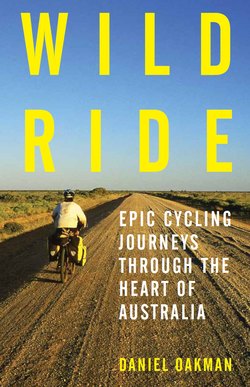Читать книгу Wild Ride - Daniel Oakman - Страница 5
На сайте Литреса книга снята с продажи.
ОглавлениеIntroduction
To cross Australia on a bicycle, piercing the very heart of the continent, facing dangers, some known and more unknown — it was the very thing.
— Jerome Murif, Australian cyclist, 1897
Bicycles changed everything. They changed not only the way people moved, they also offered a thrilling new way to see and encounter the world. Cheaper, faster and less trouble than a horse, bicycles also reignited Australia’s desire for adventure and exploration — a desire that soon became an obsession. Hardy explorers and otherwise sensible city dwellers were soon possessed by the urge to pit themselves against the vastness of the Australian continent. No proposition was too daring, no risk too great.
This book tells the story of the cyclists who were overcome by the need to venture forth on two wheels, those courageous men and women who undertook some of the most epic bicycle journeys of all time. While many of Australia’s bicycle pioneers rode to beat records or be the first, others set out for no other reason than to immerse themselves in the wild. They willingly surrendered themselves to their fate in a land at once majestic, magical and hostile. Fortunately for us, these pioneers were not content merely to ride. They wanted to share their experience with like-minded folk. And Australian readers devoured their stories — heady accounts filled with unbridled wonder, drama and derring-do.
Bicycle adventurers enjoyed bragging about their amazing journeys and the country they had seen with fresh eyes, and rightfully so. Yet, for all their swaggering audacity, the tales they told sometimes showed a surprisingly subtle appreciation of the land they encountered. While many were profoundly ignorant of life beyond the cities — most notably that of Indigenous Australians — they all emerged from their experiences entirely transformed. In turn, their stories helped shape the way Australians understood the land and its people.
In another way, these stories were a subtle dig at the ‘Mother Country’. They were a kind of mocking raspberry, blown hard at Great Britain and her genteel, middle-class cyclists who set off for delightful weekend spins along country lanes with cucumber sandwiches and tea. Collectively, these Australian tales were proof that those exiled on what for the British was the other side of the planet had more than enough grit and mettle to conquer, occupy and thrive in the barren Antipodean wilderness.
In the decades following the Second World War, cars and caravans replaced bicycles and panniers. It was a low point for Australian bike riders. But cycling did not disappear. Rather it went underground, only to re-emerge in the early years of the new century, fuelled by concerns about climate change, urban congestion and environmental sustainability. Nowadays a new trend in cycling is catching on. Wanderlust is back, and along with it a renewed passion to rediscover the wild — and ourselves.
The phenomenon known as ‘bikepacking’ is the new bike touring. Riding purpose-built bikes with lightweight gear, bikepackers have rejected the road and instead search for tracks less travelled. In many ways, today’s bikepackers ride with the same spirit of adventure and wonder as the original overlanders. Fittingly, then, the latter half of this book is dedicated to some of the more recent epic cycling trips that have drawn inspiration from our historical forebears.
Australia has a rich cycling history. There are many riders who deserve to be documented and celebrated; many journeys that have gone unheralded, been under-represented or forgotten. But this book is not an encyclopedia of endurance riding in Australia. Nor have the stories been selected at random. A major criterion for inclusion was that the ride had to be notable in ways other than simply being the first or the fastest. The journey had to be culturally significant. It had to tell us something about the times, the landscape, Indigenous Australians, the nature of long-distance cycling and, not least, the riders themselves. In short, each journey had to reveal something different about bicycle travel and the way it shaped Australian life.
The journeys retold in this book are a thrilling reminder of a period of exploration largely forgotten in the age of the motor car. We might simply choose to enjoy these feats vicariously, from the comfort of our armchairs. Or we might be inspired to venture out on our own pedal-powered explorations. At the very least, they will make our myriad excuses not to go for a ride all seem rather feeble.
